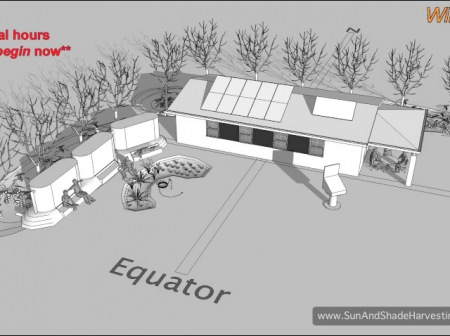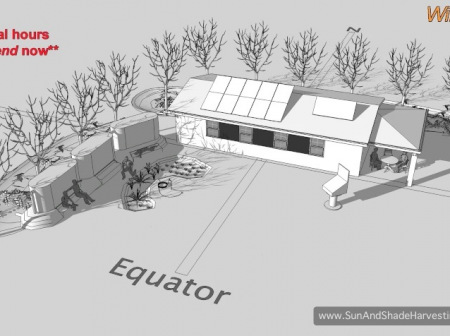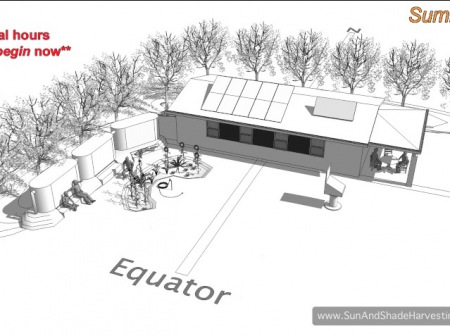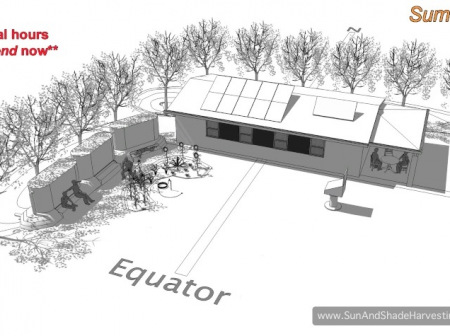Sun- & Shade-Trap Videos
by Brad Lancaster © 2015
www.HarvestingRainwater.com
There are a number of ways we can work, live, and play with the seasons’ changing sun paths to freely and passively heat, cool, and power indoor and outdoor areas. A sun & shade trap creates a protected microclimate in which to plant a garden or fruit trees, hang out, or take an outdoor nap.
See in this Winter-Solstice Sun & Shade Trap video how the layout of trees and cisterns to the west of the garden—and house to north of it—create a sun trap welcoming the winter morning sun on the garden and front porch (see figures 1A and 2A), while a shade trap is created in the afternoon when the garden and front porch are shaded and cooled by the cisterns, trees, and the house itself at the hottest time of the day (see figures 1B and 2B). This not only saves water associated with power generation, but also significantly reduces the water needs of the garden, since the shaded and cooled plants and soil will lose less moisture to evapotranspiration and evaporation than they would if exposed to the more intense heat of direct sun at the hottest time of day.
Furthermore, note how full winter sun access is maintained for all the home’s winter-sun/equator-facing windows, trombe walls (between the windows), rooftop solar PV panels, rooftop solar water heater, and solar oven during the critical hours of solar access—while optimal summer shading is also maintained for the building’s walls and windows with an ideally sized roof overhang, covered porch to the east, and shade trees to the west and north.
Note 1: The solar oven in the video moves throughout the day so that it is always facing the sun. Watch the solar oven and shadows to see where the sun is throughout the day.
Compare this Summer-Solstice Sun & Shade Trap video to the Winter-Solstice video to see how the different seasons’ sun and shadow paths vary.
If you want more morning shade, consider using a solar arc arrangement of trees (see the solar arc’s effects in winter and in summer), rather than a sun & shade trap. Note how these sun & shade traps and solar arcs are ideal for passively harvesting both winter sun and summer shade where and when needed. These are great ways to grow living air conditioners and heaters that can be freely irrigated with on-site rainfall and run-off (turned into “soak-in”) captured in passive water-harvesting earthworks or rain gardens.
Note that hardy, native, food-bearing shade trees are often the best plants for creating a sun & shade trap (or solar arc), as they are the best adapted to local climatic extremes. Thus they can buffer the extremes for gardens, gathering areas, buildings, or less-hardy exotic fruit trees within the sheltered area they create.
If you want shade earlier or later within the trap, move the elements to be shaded closer to or farther from the trap—or grow/build a taller or shorter shading element.
Note 2: These videos are for 32º N latitude. For sun and shadow paths and angles for other latitudes, plus additional strategies for the free/passive harvest of sun and shadow, see the book Rainwater Harvesting for Drylands and Beyond, Volume 1, 3rd Edition.
Additional sun- & shade-harvesting videos:
Sun- & Shade-Harvesting Awning and Roof Overhang
– Simple strategy working with the 20ºF (11ºC) or greater difference between spring and fall equinox temperatures
Winter Solstice Sun and Shadow Paths—Micro Version
– Highlights how to maintain winter access to the sun by properly placing and spacing trees and structures in relationship to equator-/winter sun-facing walls and windows
Winter Solstice Sun and Shadow Paths—Macro Version
– Shows the sun’s location and path in the sky on the winter solstice
See www.SunAndShadeHarvesting.com for still more online Sun- & Shade-Harvesting strategies, images, and resources.
For more
See the new, full-color, revised editions of Brad’s award-winning books
– available a deep discount, direct from Brad:

Volume 1
Volume 1 has detailed sun & shade harvesting info on:
- Orienting buildings and landscapes to the sun
- Designing roof overhangs and awnings to optimize winter sun and summer shade
- How to choose and size windows to optimize passive heating and cooling
- Solar arcs
- Sun & shade traps
- Maintaining winter sun access with winter-solstice shadow ratios and solar rights
- Sun angles and path for any latitude and season
- How to find your way, and true north or south, with the sun and other stars
- How to place vegetation or structures to maximize natural ventilation or windbreaks
- Table comparing the energy consumed, water consumed, and carbon emitted of active and passive clothes drying, water heating, food storage & prep, lighting, heating, and cooling strategies.





